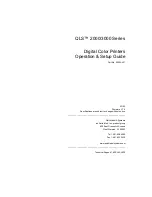
13
Labels
Labels (also called pressure-sensitive materials) are multi-ply materials consisting of a “sandwich” of various combinations
of face sheets (printable stock), adhesives, and removable protective backings (liners). The multiple layers can result in
thick, difficult-to-handle materials.
Labels are among the most difficult print materials for any printer to reliably feed and print. The heat, pressure, and paper
paths required by laser printers create a particularly difficult environment for printing labels. Temperatures near 225°C
(437°F) [temperatures vary between printers; check the section for your specific printer] and pressures to 25 psi can be
necessary for the fusing process. Heavy label stock can absorb heat, which in turn affects toner adhesion and print quality
and causes problems such as delamination.
Note:
To prevent labels peeling off or delaminating, make sure the release strength of the labels you use is
sufficient to withstand the temperature and pressure extremes generated during printing.
Label characteristics
The materials used to construct labels have a wide range of properties that can affect printing. In addition to volatile
components in adhesive, volatiles are also in some label materials. We recommend that volatile emissions from the label,
up to 160°C (320°F), should be a minimal amount. These low boiling point volatiles can produce emissions when they are
heated in the fuse,r and they can potentially produce vapors which can cause damage to the printer. Preprinted inks can
also cause printer contamination, and may be present on one or both sides of the label sheet.
Observing recommended label design guidelines can minimize contamination as well as prevent other critical problems,
such as labels peeling off and causing jams in the printer, or the label or adhesive melting if the sheet stops in the fuser
during a paper jam.
Review label designs with a converter or vendor who is knowledgeable about labels and laser printer characteristics to
ensure you use labels suitable for your application.
Note:
Before purchasing large quantities of labels, make sure you extensively test the labels with your
printer.
Printing on labels
Use full label sheets only. Partial sheets (with areas exposed by missing labels) can cause labels to peel off during printing,
resulting in a paper jam. Partial sheets can also contaminate your printer and cartridge with adhesive and can void the
printer and cartridge service warranties.
Do not feed labels through the printer more than once. Doing so may result in adhesive contamination to the cartridge and
other components.
Depending on your printer model and the number of labels you print, printing labels may require special printer
maintenance. (Look under “printer maintenance” in the index of your
User’s Guide
, publications CD, or
Software and
Documentation
CD for specific information about maintaining your printer.)
If you print large quantities of labels or other glossy print media on a Lexmark™ C750 or C752, replace the fuser housing
with a web oiler field upgrade kit (P/N 12G6307 for a 115 V printer, P/N 12G6308 for a 220 V printer).
Содержание 22L0176 - C 770dn Color Laser Printer
Страница 145: ...Index 145 Z zone coating adhesives 16 integrated forms 21 label design 17 ...
Страница 146: ...www lexmark com ...














































